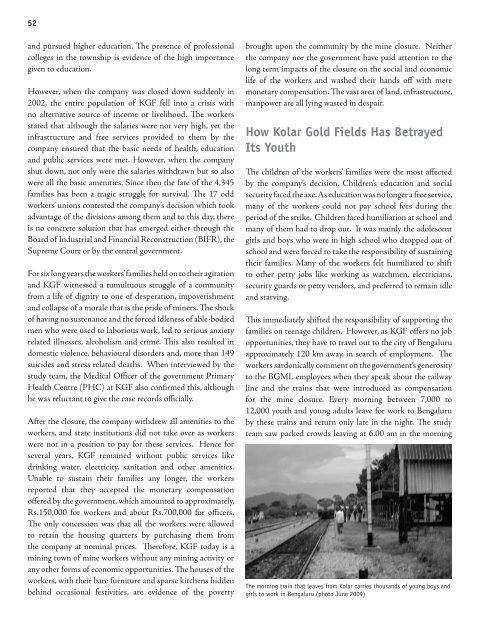52and pursued higher education. The presence of professionalcolleges in the township is evidence of the high importancegiven to education.However, when the company was closed down suddenly in2002, the entire population of KGF fell into a crisis withno alternative source of income or livelihood. The workersstated that although the salaries were not very high, yet theinfrastructure and free services provided to them by thecompany ensured that the basic needs of health, educationand public services were met. However, when the companyshut down, not only were the salaries withdrawn but so alsowere all the basic amenities. Since then the fate of the 4,345families has been a tragic struggle for survival. The 17 oddworkers’ unions contested the company’s decision which tookadvantage of the divisions among them and to this day, thereis no concrete solution that has emerged either through theBoard of Industrial and Financial Reconstruction (BIFR), theSupreme Court or by the central government.For six long years the workers’ families held on to their agitationand KGF witnessed a tumultuous struggle of a communityfrom a life of dignity to one of <strong>des</strong>peration, impoverishmentand collapse of a morale that is the pride of miners. The shockof having no sustenance and the forced idleness of able-bodiedmen who were used to laborious work, led to serious anxietyrelated illnesses, alcoholism and crime. This also resulted indomestic violence, behavioural disorders and, more than 149suici<strong>des</strong> and stress related deaths. When interviewed by thestudy team, the Medical Officer of the government PrimaryHealth Centre (PHC) at KGF also confirmed this, althoughhe was reluctant to give the case records officially.After the closure, the company withdrew all amenities to theworkers, and state institutions did not take over as workerswere not in a position to pay for these services. Hence forseveral years, KGF remained without public services likedrinking water, electricity, sanitation and other amenities.Unable to sustain their families any longer, the workersreported that they accepted the monetary compensationoffered by the government, which amounted to approximately,Rs.150,000 for workers and about Rs.700,000 for officers.The only concession was that all the workers were allowedto retain the housing quarters by purchasing them fromthe company at nominal prices. Therefore, KGF today is amining town of mine workers without any mining activity orany other forms of economic opportunities. The houses of theworkers, with their bare furniture and sparse kitchens hiddenbehind occasional festivities, are evidence of the povertybrought upon the community by the mine closure. Neitherthe company nor the government have paid attention to thelong term impacts of the closure on the social and economiclife of the workers and washed their hands off with meremonetary compensation. The vast area of land, infrastructure,manpower are all lying wasted in <strong>des</strong>pair.How Kolar Gold Fields Has BetrayedIts YouthThe children of the workers’ families were the most affectedby the company’s decision. <strong>Children</strong>’s education and socialsecurity faced the axe. As education was no longer a free service,many of the workers could not pay school fees during theperiod of the strike. <strong>Children</strong> faced humiliation at school andmany of them had to drop out. It was mainly the adolescentgirls and boys who were in high school who dropped out ofschool and were forced to take the responsibility of sustainingtheir families. Many of the workers felt humiliated to shiftto other petty jobs like working as watchmen, electricians,security guards or petty vendors, and preferred to remain idleand starving.This immediately shifted the responsibility of supporting thefamilies on teenage children. However, as KGF offers no jobopportunities, they have to travel out to the city of Bengaluruapproximately 120 km away, in search of employment. Theworkers sardonically comment on the government’s generosityto the BGML employees when they speak about the railwayline and the trains that were introduced as compensationfor the mine closure. Every morning between 7,000 to12,000 youth and young adults leave for work to Bengaluruby these trains and return only late in the night. The studyteam saw packed crowds leaving at 6.00 am in the morningThe morning train that leaves from Kolar carries thousands of young boys andgirls to work in Bengaluru (photo June 2009)
53and returning by the last train that comes into KGF at 9.00pm, and, how adolescent girls form a majority of these dailycommuters. When interviewed, the young girls who commuteby these trains admitted that they are vulnerable to physicaland sexual abuse as the trains are overcrowded, but theybrush it aside as unavoidable as they have no other choice butto work to sustain their families. A few of the girls stated thatthey have learnt to deal with these problems over the years bychoosing to travel in groups. However, they stated that themain problem was while returning home as sometimes theiremployers make them work extra hours, which means theycannot take the regular train back home. This creates tensionfor the girls when they have to travel back alone as incidents ofassault are common around the railway track in KGF.The only fortune that these young people of KGF have is theirEnglish education. They are therefore offered lower-end jobsin corporate offices, business process outsourcing (BPO),banks and other private firms that require English speakingskills. A majority of the girls work as contract labour in thegarment industries in the suburbs of Bengaluru while mostof the boys work as electricians, masons, carpenters, securityguards, plumbers and the like. The study team could not findany young people in the township during the weekdays and,during the weekends girls are normally busy with householdchores.KGF has gained notoriety of having youth hired by politicaland criminal groups, which operate in Bengaluru, for violentand criminal activities. It was also reported that some of thewomen and young girls from the workers’ families turned toprostitution to keep their families from starving. However,people of KGF prefer not to have such news highlighted asit only sensationalises KGF without actually addressing theircore problems.One of the glaring problems reported by the people themselvesis theft. Young boys operate as petty criminals and steal partsof the company infrastructure like metal sheets from mineshafts, machinery and other scrap. The team found many ofthe properties of BGML with broken doors and windows,walls stripped of cupboards, fencing material ripped away andsimilar scenes around the township. When the study teamvisited KGF, a critically injured mine worker was admitted tothe PHC and it was reported that some youth had brutallyassaulted him on the railway track and robbed him. Peoplewere bitter that these crimes were committed under theguidance of the local police who thrive on the new violenceerupting from the youth.When the youth of KGF were interviewed they expressedtheir anger and frustration at the government, and about howthe company betrayed their families and left them to sufferthe indignity of poverty without providing any alternatives.A majority of them stated that they were ready to gounderground and keen to have the mining back or demandedthat the government should set up other industries in KGF.They questioned the irrationality of the government, which istrying to forcibly acquire large areas of rich agricultural landsfrom farmers in other places for setting up SEZs, whereasKGF has 13,000 acres of land, the right infrastructure andmanpower that can readily service different industries.Some of the girls interviewed spoke bitterly about their lostopportunities as they were meritorious students and hadgained admission to professional courses like engineering buthad to forego their studies due to the financial crises sufferedby their families. All through the field visit the study teamgot the impression that workers, officers and the youth wereall living in hopeful anticipation of the mine being openedonce again and the families getting back to the golden daysof BGML.Therefore, most of the families have remained in KGF awaitingthe revival of the mines or hoping that the government willcome to their rescue with other industries. The workers’unions claim that they are now under a united federation andconfident of negotiating with the government for a revivaland are preparing the youth to be the next generation ofmine workers. However, differences were visible; the politicalenvironment of the unions and the government stance makesit seem that it is unlikely that a constructive alternative forthe youth is possible in the immediate future. The youth havepaid a heavy price for the political dead-end created by theKGF mine closure.Health ImpactsThe two most glaring problems that were identified were theoccupational illnesses related to gold mining and the socialills related to closure. The workers interviewed admitted thatalmost all of them who worked underground suffered fromsilicosis and tuberculosis. Earlier they were treated in thecompany hospital and they reported that death due to silicosiswas experienced quite frequently. However, after the mineclosed down and so also the hospital, the ex-workers sufferingfrom these illnesses today do not have medical facilities. Thegovernment PHC in KGF is unable to meet the medical
- Page 2 and 3:
India’s Childhood in the "Pits"A
- Page 4 and 5: iiiAcknowledgementsThis report, cal
- Page 6 and 7: Table of ContentsAbout the Study 3M
- Page 8 and 9: 4List of states and districts visit
- Page 10 and 11: 6However, closer observation of the
- Page 12 and 13: 8In addition, almost all work perfo
- Page 14 and 15: 10ImpactsChildren are affected dire
- Page 16 and 17: 12is mandatory and this must be ens
- Page 18 and 19: 15National OverviewMining has impac
- Page 20 and 21: 17Table 1.2: Number of illegal mine
- Page 22 and 23: 19Table 1.3: Key indicators in mini
- Page 24 and 25: 21migrate to plain areas or are con
- Page 26 and 27: 23had no land to start with and wor
- Page 28 and 29: 25Although there is no data to show
- Page 31 and 32: 28Pollution Control Board have reve
- Page 33 and 34: 30Accidents from blasting activitie
- Page 35 and 36: 32abdominal pains, arthritis, jaund
- Page 37 and 38: 34because companies can pay them le
- Page 39 and 40: 36Increase in Child Labour“The im
- Page 41 and 42: 38“My name is Sudeep. I am workin
- Page 43 and 44: 40Working conditions in the informa
- Page 45 and 46: 42Efforts to address child labour i
- Page 47 and 48: 44the situation of children living
- Page 49 and 50: 47KarnatakaState OverviewThe popula
- Page 51 and 52: 49population of Bellary continues t
- Page 53: 51Kolar Gold Fields: The Golden Gra
- Page 57 and 58: 55Bellary: Children Behind the Iron
- Page 59 and 60: 57The Condition of Children Living
- Page 61 and 62: 59In Kallali village, where there a
- Page 63 and 64: 61The anganwadi inSultanpura showed
- Page 65 and 66: 63Rangamma’s story: stone quarryi
- Page 67 and 68: 66deaths in 2004 to 174 deaths in 2
- Page 69 and 70: 68Nashik district: Key factsTotal p
- Page 71 and 72: 70Basic housing and sanitation are
- Page 73 and 74: 72Table 2.03: Santulan Pashan Shala
- Page 75 and 76: 74Table 2.05: Bal Shikshan Kendras
- Page 77 and 78: 76Table 2.07: Socio-economic distri
- Page 79 and 80: 79RajasthanState OverviewRajasthan,
- Page 81 and 82: 81Most worryingly, there has been n
- Page 83 and 84: 83Jaisalmer district: Key factsTota
- Page 85 and 86: 85According to their plans, the pri
- Page 87 and 88: 87been attending government schools
- Page 89 and 90: 89As well as malaria, the most comm
- Page 91 and 92: 91land as more and more is acquired
- Page 93 and 94: 93Madhya PradeshState OverviewThe t
- Page 95 and 96: 95Panna district: Key factsTotal po
- Page 97 and 98: 97Impact of Displacement andResettl
- Page 99 and 100: 99but a teacher is sent from the pr
- Page 101 and 102: 101or migrate to Delhi, Kanpur, Jha
- Page 103 and 104: 103ChhattisgarhState OverviewChhatt
- Page 105 and 106:
105It is hard to gauge the state’
- Page 107 and 108:
107The case study was done in Raiga
- Page 109 and 110:
109Table 2.10 gives the government
- Page 111 and 112:
111born either weak or with physica
- Page 113 and 114:
113EIA for Jindal coal mine in Chha
- Page 115 and 116:
116state, and by May 2007, had reha
- Page 117 and 118:
118pass through the town loaded wit
- Page 119 and 120:
120which is then purchased by petty
- Page 121 and 122:
122Water: A Looming Crisis for Wome
- Page 123 and 124:
124but not the actual economic live
- Page 125 and 126:
127OrissaState OverviewOrissa has a
- Page 127 and 128:
129aged between 6 and 14 years in t
- Page 129 and 130:
131cent from the previous year. 251
- Page 131 and 132:
133Rayagada district: Key factsTota
- Page 133 and 134:
135opened up in Damanjodi, Orissa.
- Page 135 and 136:
137from SC community and rest are O
- Page 137 and 138:
139Child LabourChild labour is a cl
- Page 139 and 140:
141loading one basket of the ore in
- Page 141 and 142:
143drop-out rate and there are only
- Page 143 and 144:
145reason, according to them, for s
- Page 145 and 146:
147UAIL earlier a joint venture of
- Page 147 and 148:
149Table 2.24: Some demographic det
- Page 149 and 150:
151Table 2.27: Some figures regardi
- Page 151 and 152:
153Orissa including Kasipur is well
- Page 153 and 154:
155Table 2.28: Details of some of t
- Page 155 and 156:
157Table 2.30: Village data from Ce
- Page 157 and 158:
159regularly, so the children go fo
- Page 159 and 160:
161the Joda and Barbil region with
- Page 161 and 162:
163Abuse of Children in the Media b
- Page 163 and 164:
166from TB in the state and the sta
- Page 165 and 166:
168Cuddapah district: Key factsTota
- Page 167 and 168:
170Problems of Mine Workers’ Chil
- Page 169 and 170:
172their parents and were driven by
- Page 171 and 172:
174want to see their children sucke
- Page 173 and 174:
176Kids Being Trafficked from N.E.
- Page 175 and 176:
179Summary and RecommendationsAlmos
- Page 177 and 178:
181Health problems of children livi
- Page 179 and 180:
studies here can help evoke a glimm
- Page 181 and 182:
185addressed to include all mining
- Page 183 and 184:
187made by the monitoring committee
- Page 185 and 186:
Part IVAppendix- Our Experience wit
- Page 187 and 188:
192Table 2.44 presents some of the
- Page 189 and 190:
194Goachildren in Cuddalore distric
- Page 191 and 192:
1965. Schools established, number o
- Page 193 and 194:
198ConclusionsThe RTI Act is intend
- Page 195 and 196:
Maharashtra199The table shows that
- Page 197 and 198:
201Data of children’s education i
- Page 199 and 200:
203Data of drop-out children in Bel
- Page 201 and 202:
206Human Development Index (HDI): C
- Page 203:
!!"#






